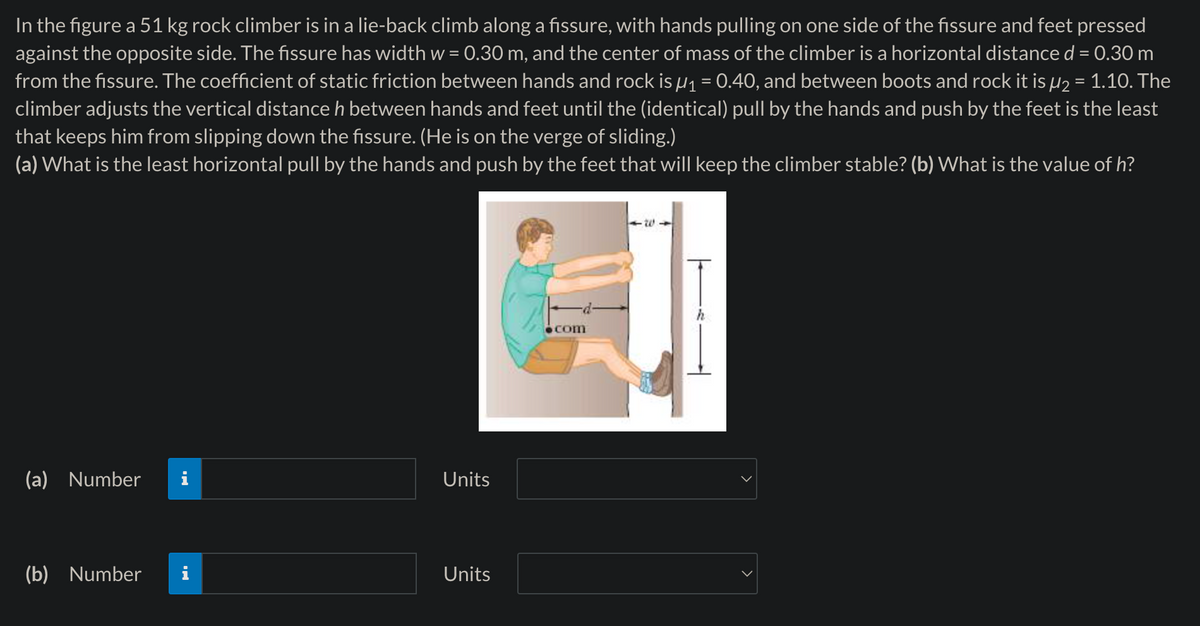In the figure a 51 kg rock climber is in a lie-back climb along a fissure, with hands pulling on one side of the fissure and feet pressed against the opposite side. The fissure has width w = 0.30 m, and the center of mass of the climber is a horizontal distance d = 0.30 m from the fissure. The coefficient of static friction between hands and rock is µ₁ = 0.40, and between boots and rock it is µ2 = 1.10. The climber adjusts the vertical distance h between hands and feet until the (identical) pull by the hands and push by the feet is the least that keeps him from slipping down the fissure. (He is on the verge of sliding.) (a) What is the least horizontal pull by the hands and push by the feet that will keep the climber stable? (b) What is the value of h? (a) Number Units (b) Number Units com
In the figure a 51 kg rock climber is in a lie-back climb along a fissure, with hands pulling on one side of the fissure and feet pressed against the opposite side. The fissure has width w = 0.30 m, and the center of mass of the climber is a horizontal distance d = 0.30 m from the fissure. The coefficient of static friction between hands and rock is µ₁ = 0.40, and between boots and rock it is µ2 = 1.10. The climber adjusts the vertical distance h between hands and feet until the (identical) pull by the hands and push by the feet is the least that keeps him from slipping down the fissure. (He is on the verge of sliding.) (a) What is the least horizontal pull by the hands and push by the feet that will keep the climber stable? (b) What is the value of h? (a) Number Units (b) Number Units com
Physics for Scientists and Engineers: Foundations and Connections
1st Edition
ISBN:9781133939146
Author:Katz, Debora M.
Publisher:Katz, Debora M.
Chapter5: Newton's Laws Of Motion
Section: Chapter Questions
Problem 76PQ: Jamal and Dayo are lifting a large chest, weighing 207 lb, by using the two rope handles attached to...
Related questions
Question

Transcribed Image Text:In the figure a 51 kg rock climber is in a lie-back climb along a fissure, with hands pulling on one side of the fissure and feet pressed
against the opposite side. The fissure has width w = 0.30 m, and the center of mass of the climber is a horizontal distance d = 0.30 m
from the fissure. The coefficient of static friction between hands and rock is µ₁ = 0.40, and between boots and rock it is µ2 = 1.10. The
climber adjusts the vertical distance h between hands and feet until the (identical) pull by the hands and push by the feet is the least
that keeps him from slipping down the fissure. (He is on the verge of sliding.)
(a) What is the least horizontal pull by the hands and push by the feet that will keep the climber stable? (b) What is the value of h?
(a) Number
Units
(b) Number
Units
com
Expert Solution
This question has been solved!
Explore an expertly crafted, step-by-step solution for a thorough understanding of key concepts.
This is a popular solution!
Trending now
This is a popular solution!
Step by step
Solved in 2 steps

Recommended textbooks for you

Physics for Scientists and Engineers: Foundations…
Physics
ISBN:
9781133939146
Author:
Katz, Debora M.
Publisher:
Cengage Learning

Classical Dynamics of Particles and Systems
Physics
ISBN:
9780534408961
Author:
Stephen T. Thornton, Jerry B. Marion
Publisher:
Cengage Learning

Physics for Scientists and Engineers: Foundations…
Physics
ISBN:
9781133939146
Author:
Katz, Debora M.
Publisher:
Cengage Learning

Classical Dynamics of Particles and Systems
Physics
ISBN:
9780534408961
Author:
Stephen T. Thornton, Jerry B. Marion
Publisher:
Cengage Learning